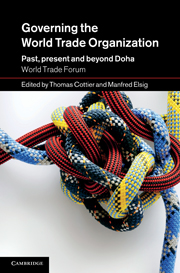Book contents
- Frontmatter
- Contents
- List of figures
- List of tables
- Notes on Contributors
- Preface
- List of abbreviations
- 1 Introduction
- PART I Setting the stage
- 2 The origins and back to the future: a conversation with Ambassador Julio Lacarte Muró
- 3 After globalisation? WTO reform and the new global political economy
- PART II Boundaries
- PART III Emerging and established powers
- PART IV Weaker actors
- PART V The consensus principle
- PART VI Quo vadis?
- Index
2 - The origins and back to the future: a conversation with Ambassador Julio Lacarte Muró
Published online by Cambridge University Press: 07 September 2011
- Frontmatter
- Contents
- List of figures
- List of tables
- Notes on Contributors
- Preface
- List of abbreviations
- 1 Introduction
- PART I Setting the stage
- 2 The origins and back to the future: a conversation with Ambassador Julio Lacarte Muró
- 3 After globalisation? WTO reform and the new global political economy
- PART II Boundaries
- PART III Emerging and established powers
- PART IV Weaker actors
- PART V The consensus principle
- PART VI Quo vadis?
- Index
Summary
Mr Ambassador: making decisions at the GATT/WTO; how did it all start?
The genesis of GATT was a Preparatory Committee for a world conference on trade and employment which was to be held in Havana in late 1947 and early 1948; this Preparatory Committee was appointed by the Economic and Social Council of the United Nations and comprised some twenty-odd members. The intention was that the International Trade Organization to be set up at Havana would join the World Bank and the International Monetary Fund as the backbone of the post-war scheme for inter-governmental cooperation in trade, financial and monetary issues.
And who were those 20-odd members?
Almost inevitably they were a reflection of the winning alliance of the Second World War. They included Great Britain, Canada, South Africa, Australia, New Zealand and India; that is, six from the British Commonwealth. The United States, Cuba – which was at the time very close to the United States, due to the sugar quota issue – and Brazil, which had sent troops to Europe in the Second World War. Inevitably, there was France together with the Benelux countries (Belgium, the Netherlands and Luxembourg). Norway, which had also been a belligerent and whose government had taken refuge in Britain throughout the Second World War, was represented. So, out of the total membership of the Preparatory Committee countries, the majority had been Allies and they were the countries that were most influential in pushing in favour of the whole process of the world trading system.
- Type
- Chapter
- Information
- Governing the World Trade OrganizationPast, Present and Beyond Doha, pp. 13 - 19Publisher: Cambridge University PressPrint publication year: 2011
- 1
- Cited by



